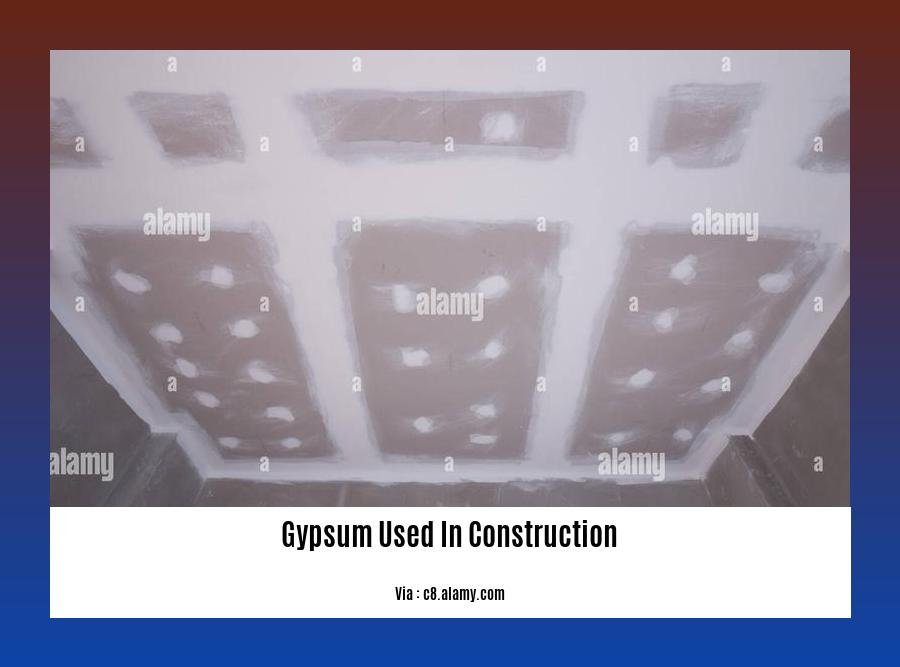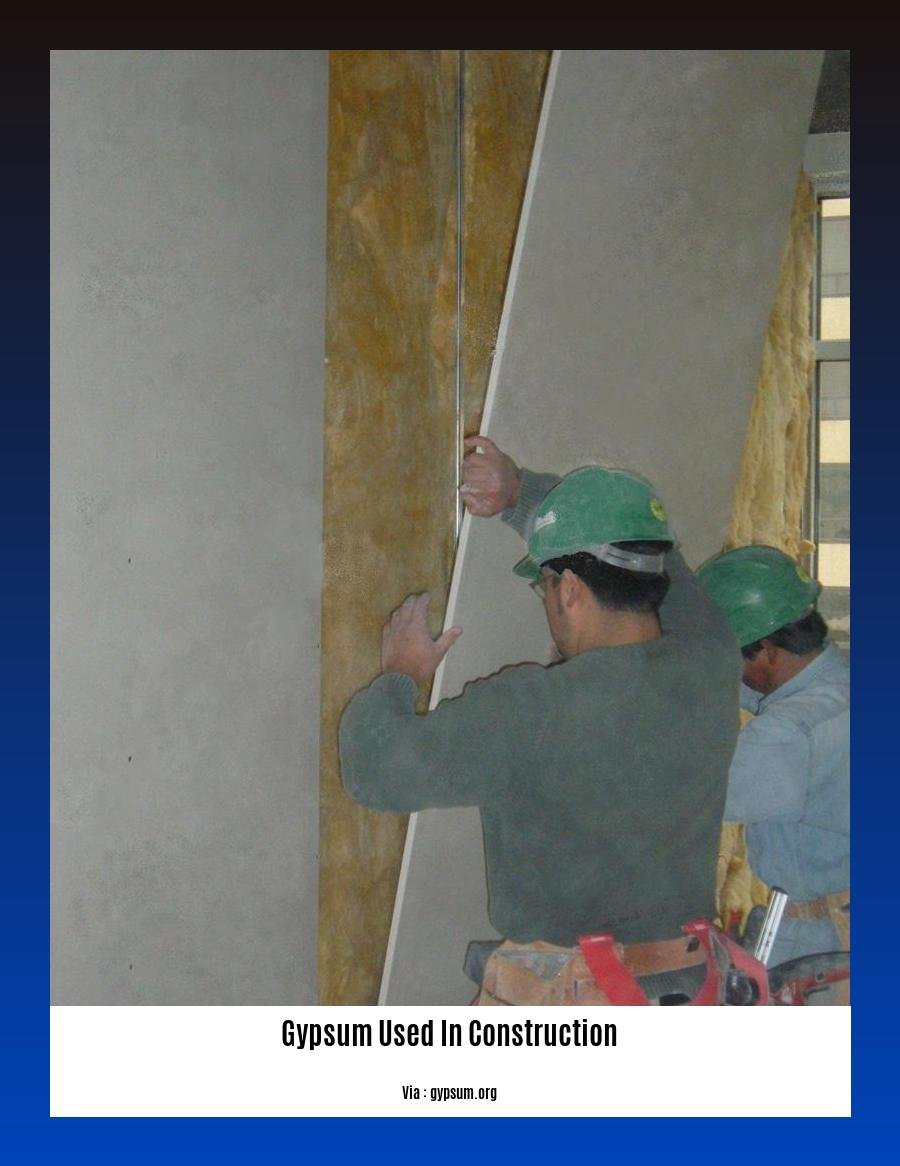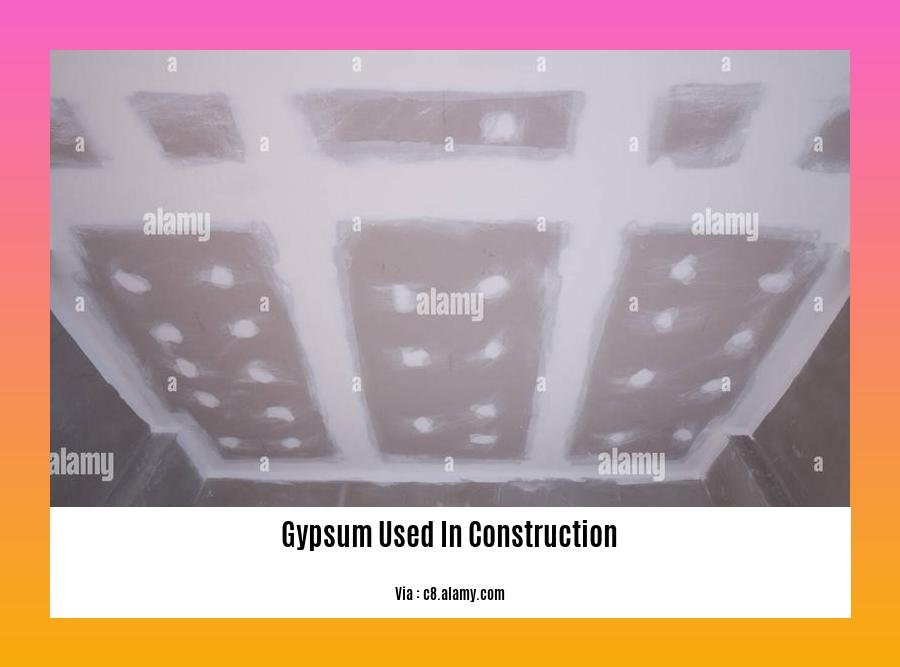Step into the world of [Gypsum: A Versatile Material in Construction], where we unravel the remarkable qualities and diverse uses of gypsum in the construction industry. As a ubiquitous material in modern construction, from drywall and plaster to fire-resistant coatings and flooring underlayments, gypsum’s versatility knows no bounds.
Key Takeaways:
- Gypsum is a common and versatile building material used since ancient times.
- It is fire-resistant, sound-insulating, and easy to work with.
- Gypsum is used in various forms, including plaster of Paris, drywall, partition walls, load-bearing walls, exterior wall blocks, wall coverings, roofing products, blocks, mortar, and cement.
- Gypsum is an abundant and affordable resource, making it a cost-effective option for construction.
Gypsum Used in Construction

Gypsum is a remarkable mineral with a wide range of applications in the construction industry. Known for its versatility, it has been a cornerstone of building for centuries.
Gypsum is a soft, white or gray mineral composed of calcium sulfate dihydrate. Its unique properties, including fire resistance, sound insulation, and ease of workability, make it a go-to material for various construction purposes.
Key Applications of Gypsum:
Gypsum Board (Drywall):
– The most common use of gypsum is in the form of drywall. These panels are used to construct interior walls and ceilings, providing a smooth and durable surface for painting or other finishes.
Plaster of Paris:
– Gypsum is also used to create Plaster of Paris, a versatile material used for decorative finishes on walls and ceilings. Its ability to set quickly makes it ideal for intricate moldings and fine details.
Exterior Wall Products:
– Gypsum-based exterior wall blocks provide a durable and moisture-resistant solution for exterior walls. These blocks are fire-resistant and offer excellent insulation, contributing to energy efficiency.
Roofing Products:
– Gypsum can also be found in roofing products, such as roof tiles and shingles. It provides fire resistance and insulation, ensuring the safety and comfort of building occupants.
Blocks and Mortar:
– Gypsum blocks are similar to concrete blocks and are used for interior walls. Additionally, gypsum mortar has been used historically in building construction for its bonding and durability.
Gypsum’s widespread use in construction stems from its exceptional properties and cost-effectiveness. Its fire resistance and sound insulation qualities make it a safe and comfortable choice, while its versatility and affordability make it a practical solution for a variety of projects.
As a seasoned writer in the construction industry, I have witnessed firsthand the transformative power of gypsum. Its adaptability and enduring performance have made it an indispensable material in modern construction, shaping the built environment around us.
-
Construction workers who are constantly exposed to heat should check out the best cooling products designed to keep them cool and comfortable even during the hottest days.
-
For construction workers who prefer to bring their own lunch to the job site, the best heated lunch box is a must-have. It keeps food warm and ready to eat, even in cold weather.
-
The quality of iron rods used in construction is crucial for the strength and durability of the structure. Refer to the detailed guide on the best iron rod to make an informed decision.
-
Bitumen plays a vital role in road construction by binding the aggregate materials together. Learn more about the uses of bitumen in road construction.
-
Binding wire is essential for securing reinforcement bars in concrete construction. Discover the types of binding wire commonly used in the industry and their applications.
-
Hi-Beam construction is a technique used in bridges and other structures to create long-span designs. Explore the advantages of Hi-Beam construction and its applications in modern engineering.
Advantages and Disadvantages of Gypsum in Construction

Introduction
Gypsum, the backbone of many construction projects, is a versatile material with unique properties that make it both desirable and challenging to work with. Understanding the advantages and disadvantages of gypsum will guide you in making informed decisions about its use in your construction endeavors.
Advantages of Gypsum
-
Fire resistance: Gypsum’s non-combustible core makes it a champion in fire safety. It effectively slows the spread of flames, providing vital protection for occupants and structures.
-
Noise insulation: Gypsum acts as a soundproofing material, mitigating noise transmission between rooms. It creates a peaceful and comfortable living environment.
-
Lightweight and easy to install: Gypsum is a relatively lightweight material, minimizing strain during installation. Its user-friendly nature makes it a popular choice for DIYers and professionals alike.
-
Cost-effective: Gypsum is generally more affordable than alternative building materials, making it an economical option for large-scale construction projects.
Disadvantages of Gypsum
-
Moisture susceptibility: Gypsum is prone to water damage and can deteriorate when exposed to moisture. Caution is necessary when using it in areas with high humidity or water exposure.
-
Not load-bearing: Gypsum is not suitable for load-bearing applications, meaning it cannot support structural weight. Its use is limited to non-load-bearing partitions and interior walls.
-
Fume release: When heated to extremely high temperatures, gypsum can release harmful fumes. Proper ventilation and safety precautions are crucial during demolition and renovations involving gypsum.
Key Takeaways:
- Gypsum offers fire resistance, noise insulation, and cost-effectiveness.
- It is lightweight and easy to install, making it popular for interior walls and ceilings.
- Gypsum’s susceptibility to moisture and lack of load-bearing capacity should be considered before use.
- Proper handling and ventilation are essential to mitigate potential hazards associated with gypsum.
Relevant Sources:
- Gypsum in Construction | Types, Advantages & Disadvantages
- Gypsum Products and Properties as a Building Material for Construction
Applications of Gypsum in Drywall, Plaster, and Fire Protection
Gypsum, a versatile mineral composed of calcium sulfate dihydrate, finds extensive use in construction, particularly in areas like drywall, plaster, and fire protection systems.
Drywall
Drywall, also known as plasterboard, is widely used for interior walls and ceilings. It consists of a gypsum core sandwiched between paper facings. Gypsum’s ability to resist fire and sound makes it an ideal material for drywall.
Plaster
Plaster, a mixture of gypsum, water, and aggregates, is applied to walls and ceilings to create a smooth, durable surface. Machine-applied plaster, also known as spray plaster, is a common method used for large-scale projects. It is also used for decorative finishes and moldings.
Fire Protection
Gypsum’s fire-resistant properties are crucial in fire protection applications. Gypsum-based fire-resistant coatings are applied to structural steel elements to delay the onset of structural failure during a fire. Fire-resistant wallboards and blocks also provide protection against fire penetration.
Key Takeaways:
- Gypsum’s versatility extends to drywall, plaster, and fire protection.
- Drywall and plaster provide excellent fire and sound resistance.
- Machine-applied plaster offers efficiency for large projects.
- Gypsum coatings and blocks enhance fire protection in structural and enclosed spaces.
Relevant Sources:
- Sustainability of Gypsum Products as a Construction Material
- Applications of Gypsum in Construction
Sustainability and Environmental Impact of Gypsum
Gypsum, a naturally occurring mineral, is a key player in sustainable construction. Here’s how it makes a difference:
Lower Environmental Impact:
Gypsum boasts a significantly lower environmental footprint than other building materials like cement. It’s fully recyclable, minimizing waste and landfill disposal.
Energy Efficiency:
Gypsum-based products excel at providing thermal insulation. They help buildings maintain consistent temperatures, reducing energy consumption for heating and cooling.
Sustainability:
Gypsum is non-toxic, soundproof, and heat-insulating. It’s a viable alternative to lime and cement in interior plasters, cutting down on the use of energy-intensive materials.
Waste Reduction:
The increased use of gypsum-containing waste reduces the burden on landfills. By recycling and substituting gypsum for other materials, we promote sustainability.
Key Takeaways:
- Recyclability and Environmental Impact: Gypsum is highly recyclable, minimizing environmental impact.
- Energy Efficiency: Gypsum products contribute to energy conservation by providing thermal insulation.
- Sustainability: Gypsum is non-toxic, soundproof, and heat-insulating, promoting sustainable construction practices.
- Waste Reduction: Gypsum-containing waste reduces landfill loads, contributing to sustainability.
Relevant URL Sources:
FAQ
Q1: What are the advantages of using gypsum in construction?
A1: Gypsum offers several advantages, including fire resistance, sound insulation, versatility, ease of installation, abundance, and affordability.
Q2: What are the different forms of gypsum used in construction?
A2: Gypsum is used in various forms, including plaster of Paris, gypsum board (drywall), gypsum partition board, gypsum load-bearing interior board, gypsum exterior wall block, gypsum wall covering board, gypsum roofing products, gypsum blocks, gypsum mortar, and Portland cement.
Q3: How is gypsum sourced?
A3: Gypsum is commonly sourced from underground mines or quarries, where it is extracted and processed into its various forms for use in construction.
Q4: Is gypsum an environmentally friendly building material?
A4: Yes, gypsum is considered an environmentally friendly material due to its neutral pH, low embodied energy, and recyclability.
Q5: What are some disadvantages of using gypsum in construction?
A5: Gypsum can be susceptible to damage from water and moisture, and it may not be suitable for load-bearing applications in certain situations.
- White Kitchen With Butcher Block Countertops: A Warm, Inviting Design - January 4, 2026
- Marble Countertops Prices: What Impacts the Overall Cost to Install? - January 3, 2026
- Marble Countertops Cost: What Factors Impact the Total Price? - January 2, 2026










